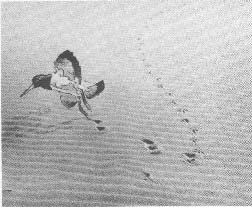 LATE IN 1967 a book was published in England which is as charming as it must be fascinating to all who are interested in the theory and practice of interpretation. Its principal author is the Dutch naturalist and ethologist Niko Tinbergen, who combined with a friend and artist to photograph the tracks left in the sand of the dunes by a variety of creatures and to reconstruct the stories they reveal in word and in image. The illustration I selected (Figure 1) shows the tracks of an oyster catcher peacefully walking along over the dunes till something apparently alarmed it, the walk turned into a hop, leaving deeper imprints in the sand, and it took off on its wings. This is not all the naturalists could infer from the configuration of the sand. They know that a bird cannot take off except precisely against the wind. At the time of the event, therefore, the wind must have blown from the left of the picture. But if you observe the ripples of the sand, they were formed by a wind coming from the direction of the camera. Accordingly, the tracks correctly interpreted reveal another story of the past: there was a change of wind between the formation of the ripples and that of the footprints. Not all of the picture illustrated is a photograph. What the artist has done is to superimpose on it his reconstruction of the oyster catcher taking off. This is how it appears to his mind’s eye and how, he is sure, it would have looked to the camera if one had been present at the moment.
LATE IN 1967 a book was published in England which is as charming as it must be fascinating to all who are interested in the theory and practice of interpretation. Its principal author is the Dutch naturalist and ethologist Niko Tinbergen, who combined with a friend and artist to photograph the tracks left in the sand of the dunes by a variety of creatures and to reconstruct the stories they reveal in word and in image. The illustration I selected (Figure 1) shows the tracks of an oyster catcher peacefully walking along over the dunes till something apparently alarmed it, the walk turned into a hop, leaving deeper imprints in the sand, and it took off on its wings. This is not all the naturalists could infer from the configuration of the sand. They know that a bird cannot take off except precisely against the wind. At the time of the event, therefore, the wind must have blown from the left of the picture. But if you observe the ripples of the sand, they were formed by a wind coming from the direction of the camera. Accordingly, the tracks correctly interpreted reveal another story of the past: there was a change of wind between the formation of the ripples and that of the footprints. Not all of the picture illustrated is a photograph. What the artist has done is to superimpose on it his reconstruction of the oyster catcher taking off. This is how it appears to his mind’s eye and how, he is sure, it would have looked to the camera if one had been present at the moment.